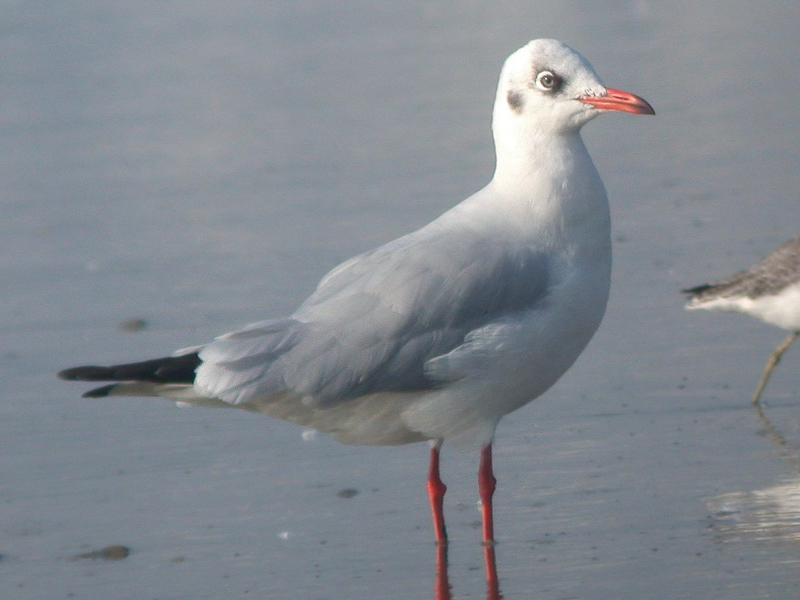Brown-headed Gull Chroicocephalus brunnicephalus 棕頭鷗
Category I. Rare winter visitor and scarce passage migrant to Deep Bay.
IDENTIFICATION

Jan. 2006, CHEUNG Mok Jose Alberto. Adult winter.
41-45 cm. Slightly larger and sturdier than Black-headed Gull with deeper bill, relatively larger head, pale iris and more prominent white crescents around eye. At rest the underside to the outer primary differs from the pattern shown by Black-headed Gull in lacking the white wedge outlined in black. The adult in winter has a small dark patch immediately in front of the eye, an ear patch that is slightly larger and darker than Black-headed Gull but less dark on the crown. The legs are slightly deeper red.

Apr. 2017, Michelle and Peter Wong. Adult, breeding plumage.
Adult in breeding plumage has dark brown hood (bordered black, though this may be difficult to see) that is paler at the front, and small narrow white crescents above and behind the eye.

Jan. 2006, John and Jemi Holmes. Adult winter.
In flight adult has a distinctive black wing tip with two large mirrors in outer two primaries.
First-year birds have extensive dark brown in the primaries and wholly dark brown secondaries; the bases to the outer primaries and most of the inner webs of the inner primaries form a large pale patch in the outer wing. The tail is broadly tipped dark brown and there are brown centres to most of the lesser and median coverts. Some first-year Black-headed Gulls have very dark upper wings that resemble Brown-headed, but the former can be identified by the longer white fingers on the outer webs of primaries 6, 7 and 8 (Gibbins 2021).
VOCALISATIONS
Calls are very similar to those of Black-headed Gull.
DISTRIBUTION & HABITAT PREFERENCE
Most reports prior to 1981 came from Victoria Harbour and the coastline to the west. The shoreline and offshore islands from Kwai Chung west to Castle Peak Bay (including Tsing Yi, Stonecutters, Ting Kau and Ma Wan) was a regular wintering area for one or more birds. It is significant that since 1981 there has not been a single report from the Harbour. The loss of attractive feeding areas along the Kowloon peninsula and west to the Castle Peak Bay shoreline due to industrial development, land reclamation and changes in sewage treatment in the form of the relocation of disposal areas into deeper waters since the 1980s presumably accounts for this. Several reports in the late 1970s also came from the former airport at Kai Tak during regular survey work.
Deep Bay has proved to be the favoured wintering area since the mid-1980s, with only three records since 1982 elsewhere, at Starling Inlet in 1985, 1990 and 1991.
OCCURRENCE
The first record for Hong Kong concerned an adult off Green Island on 21 November 1974 (Melville 1977). Since then, it has been recorded annually in small numbers. The earliest date of occurrence is 21 October 1995, when an adult was at Mai Po, and the latest, an adult in breeding plumage, was at the same site on 7 May 2017.
Figure 1 illustrates the pattern of occurrence up to 1998 compared with that since. The earlier period saw regular records in the final months of the year; however, in the later period there has only been one. In addition, there appears to have been a fall in the number of midwinter records. Most records now occur in March and April indicating that Brown-headed Gull is largely a passage migrant in spring. This may be related to milder winters allowing birds to remain further north and west.
One, occasionally two, birds are usually reported. The same was the case in earlier period, but there were also saw counts of six at Starling Inlet and Deep Bay in the winter of 1990-91 and three adults together in Deep Bay on 7 March 1992.
BEHAVIOUR, FORAGING & DIET
No information.
RANGE & SYSTEMATICS
Monotypic. Breeds between 3,000 m and at least 4,500 m in Turkestan and west China south to the Pamirs, Ladakh and Tibet; winters on coasts of India, Sri Lanka and southeast Asia to southwest China (Gochfeld and Garcia 2020). In China breeds in high plateau areas of the west and winters in the southwest (Liu and Chen 2020).
CONSERVATION STATUS
IUCN: Least Concern. Population trend stable.
Figure 1.

Burger, J., M. Gochfeld, and E. F. J. Garcia (2020). Brown-headed Gull (Chroicocephalus brunnicephalus), version 1.0. In Birds of the World (J. del Hoyo, A. Elliott, J. Sargatal, D. A. Christie, and E. de Juana, Editors). Cornell Lab of Ornithology, Ithaca, NY, USA. https://doi.org/10.2173/bow.bnhgul1.01
Gibbins, C. (2021). Dark-winged Black-headed Gulls Chroicocephalus ridibundus and their separation from Brown-headed Gulls C. brunnicephalus and hybrids. J. Asian Ornithology 37 (2021): 48-59.
Liu, Y. and Y. H. Chen (eds) (2020). The CNG Field Guide to the Birds of China (in Chinese). Hunan Science and Technology Publication House, Changsha.
Melville, D. S. (1977). New Laridae records from Hong Kong. Bull. B.O.C. 93: 34-37.

